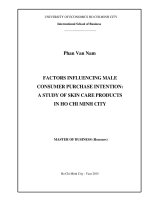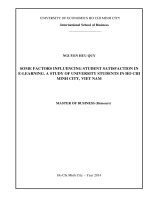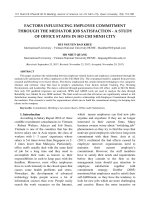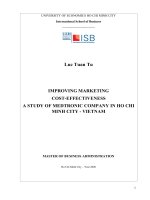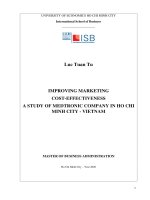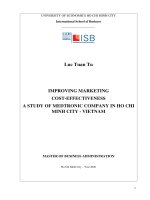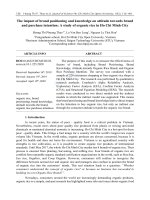Factors influencing male consumer puchase intentions a study of care products in ho chi minh city
Bạn đang xem bản rút gọn của tài liệu. Xem và tải ngay bản đầy đủ của tài liệu tại đây (1.5 MB, 85 trang )
UNIVERSITY OF ECONOMICS HO CHI MINH CITY
International School of Business
------------------------------
Phan Van Nam
FACTORS INFLUENCING MALE
CONSUMER PURCHASE INTENTION:
A STUDY OF SKIN CARE PRODUCTS
IN HO CHI MINH CITY
MASTER OF BUSINESS (Honours)
Ho Chi Minh City - Year 2015
UNIVERSITY OF ECONOMICS HO CHI MINH CITY
International School of Business
------------------------------
Phan Van Nam
FACTORS INFLUENCING MALE
CONSUMER PURCHASE INTENTION:
A STUDY OF SKIN CARE PRODUCTS
IN HO CHI MINH CITY
ID: 22120095
MASTER OF BUSINESS (Honours)
SUPERVISOR:
Dr. VO THI NGOC THUY
Ho Chi Minh City - Year 2015
DECLARATION
I hereby declare that this thesis titled “Factors influencing consumer purchase
intention: A study of private labels in Ho Chi Minh City” is definitely my own work
and effort and that is has not been submitted anywhere for any award. Where other
sources of information have been used in this thesis, they have seriously been cited.
Signature: Phan Van Nam
Date: 08/02/2015
1|Page
ACKNOWLEDGEMENTS
This thesis has been implemented with the contributions and encouragements from
faculty of International School of Business - University of Economics Ho Chi Minh
City, family, and friends. I would like to express our gratitude to all of their supports.
Without these supports, I would have had a tough time.
Firstly, I would like to give big thanks to my supervisors at International School of
Business - University of Economics Ho Chi Minh City, Professor Nguyen Dinh Tho
and Doctor Vo Thi Ngoc Thuy. Their knowledge, experiences and helps have really
been useful for me to make this thesis such as their encouragements, and patience in
providing valuable regards and recommendations on previous drafts. Without their
guidance, my thesis would not have been completed.
Secondly, I would like to address the deep appreciation to people who had read and
gave the information and advices that have made my thesis possible.
Finally, I would like to thank all people in Ho Chi Minh City who had cooperated to
answer my questionnaire.
2|Page
TABLE OF CONTENT
ABSTRACT ............................................................................................................... 8
Chapter 1: INTRODUCTION .................................................................................. 9
1.1 Background ........................................................................................................... 9
1.2 Management problems and questions..................................................................... 9
1.3 Research objectives and values ............................................................................ 10
1.4 Scope................................................................................................................... 10
1.5 Structure of study................................................................................................. 10
Chapter 2: LITERATURE REVIEW, HYPOTHESES AND RESEARCH
MODEL ................................................................................................................... 12
2.1 Introduction ......................................................................................................... 12
2.2 Theory of Reasoned Action (TRA) ...................................................................... 12
2.3 Normative factors impact on men purchasing behaviors ...................................... 13
2.3.1 Family .............................................................................................................. 13
2.3.2 Spouse .............................................................................................................. 14
2.3.3 Friend ............................................................................................................... 14
2.4 Product attributes impact on men purchasing behaviors ....................................... 14
2.4.1 Quality.............................................................................................................. 15
2.4.2 Packaging ......................................................................................................... 15
2.4.2 Price ................................................................................................................. 15
2.4.3 Brand................................................................................................................ 16
2.5 Personal image..................................................................................................... 16
2.6 Men’s attitudes toward applying skin care products ............................................. 17
2.7 Purchase intention................................................................................................ 18
2.8 Research Model ................................................................................................... 19
2.8.1 The relationship between Personal Image and Normative Influences ................ 19
2.8.2 The relationship between Beliefs in Product Attributes and Attitudes ............... 19
2.8.3 The Relationship between Personal Image and Attitudes .................................. 20
2.8.4 The relationship between Normative Influences and Behavior Intention ........... 20
3|Page
2.8.5 The relationship between Attitudes and Behavior Intention .............................. 21
2.9 Summary ............................................................................................................. 21
Chapter 3: RESEARCH METHODOLOGY......................................................... 22
3.1 Introduction ......................................................................................................... 22
3.2 Research design ................................................................................................... 22
3.2.1 Qualitative research .......................................................................................... 22
3.2.2 Quantitative research ........................................................................................ 22
3.3 Population, sample size and sampling method ..................................................... 23
3.4 Data collection..................................................................................................... 24
3.5 Data analysis........................................................................................................ 24
3.6 Research process ................................................................................................. 25
3.6.1 Adjust the scale................................................................................................. 25
3.6.2 Pilot study......................................................................................................... 25
3.6.3 Formal study..................................................................................................... 25
3.7 Measurement scale .............................................................................................. 26
3.7.1 Beliefs in product attributes .............................................................................. 27
3.7.2 Normative influences ........................................................................................ 28
3.7.3 Personal image.................................................................................................. 28
3.7.4 Attitudes toward applying skin care products .................................................... 29
3.7.5 Purchase intention............................................................................................. 29
3.8 Summary ............................................................................................................. 30
Chapter 4: DATA ANALYSIS AND RESULTS.................................................... 32
4.1 Introduction ......................................................................................................... 32
4.2 Descriptive of statistics ........................................................................................ 33
4.3 Reliability analysis (Cronbach’s Alpha coefficient) ............................................. 34
4.4 Exploratory Factor Analysis (EFA)...................................................................... 35
4.5 Confirmatory Factor Analysis (CFA)................................................................... 35
4.5.1 Introduction for CFA ........................................................................................ 35
4.5.2 CFA factor “Beliefs in product attributes” testing ............................................. 36
4|Page
4.5.3 CFA 3 factors personal image, attitudes toward applying skin care products and
purchase intention testing .......................................................................................... 38
4.5.4 CFA factor “Normative influences” testing....................................................... 40
4.5.5 Composite reliability (CR) and average variance extracted (AVE) testing ........ 41
4.5.6 CFA for whole model testing ............................................................................ 42
4.6 Structural equation modeling (SEM).................................................................... 45
4.6.1 SEM result........................................................................................................ 45
4.6.2 Model estimations by bootstrap ........................................................................ 47
4.6.3 Hypothesis testing............................................................................................. 48
4.7 Summary ............................................................................................................. 49
Chapter 5: CONCLUSIONS................................................................................... 50
5.1 Introduction ......................................................................................................... 50
5.2 Research findings ................................................................................................ 50
5.3 Limitations and direction for further research ...................................................... 52
5.4 Managerial implications....................................................................................... 53
5.5 Conclusions ......................................................................................................... 54
REFERENCES ........................................................................................................ 55
APPENDIX A: Reliability analysis (Cronbach’s Alpha coefficient) ..................... 62
APPENDIX B: Exploratory factor analysis (EFA)................................................ 67
APPENDIX C: Qualitative questionnaire .............................................................. 70
APPENDIX D: Quantitative questionnaire............................................................ 74
5|Page
LIST OF FIGURES
Figure 2.1: Research model ....................................................................................... 19
Figure 3.1 Research process ...................................................................................... 26
Figure 4.1: CFA factor beliefs in product attributes (Standardized estimates) ............ 38
Figure 4.2: CFA factor personal image, attitudes toward applying skin care products
and purchase intention (Standardized estimates) ........................................................ 40
Figure 4.3: CFA factor normative influences (Standardized estimates) ...................... 41
Figure 4.4: CFA result for whole model (Standardized estimates) ............................. 44
Figure 4.5: Estimated structural model (Standardized estimates) ............................... 47
6|Page
LIST OF TABLES
Table 3.1: Timeline of research implement ................................................................ 25
Table 3.2: Sources of questionnaire ........................................................................... 29
Table 4.1: Descriptive of statistics ............................................................................. 33
Table 4.2: Correlation between 4 components ........................................................... 37
Table 4.3: Correlations between 3 components .......................................................... 39
Table 4.4: Summarizes the results of testing the scales .............................................. 42
Table 4.5: Compares CFA results of between the two times implementations............ 43
Table 4.6: Correlations between 5 concepts ............................................................... 45
Table 4.7: Results of testing the causal relationships between studied concepts ......... 46
Table 4.8: Estimated result by the bootstrap with N = 1000 ....................................... 46
Table 4.9: Summary result of testing hypothesis........................................................ 49
7|Page
ABSTRACT
The research aims to some factors affecting on men's intention to buy male skin care
products in Ho Chi Minh City, Vietnam. Fishbein and Ajzen’s theory of reasoned
action model is applied as a theoretical framework to conduct the research; it is also
supported factor "personal image". The research question measures the impact of
factors "beliefs in product attributes, personal image, normative influences, and
attitudes toward applying skin care products" to men's consumer purchase intention on
buying male skin care products. Based on research purposes, a questionnaire was
developed and distributed selectively to Vietnamese male consumers aged 23 to 55
years in Ho Chi Minh City who work both indoors and outdoors. 250 appropriate
questionnaires were collected and then tested model fit by confirmatory factor analysis
and structural equation modeling in Amos version 22. The results of the study confirm
that all factors "beliefs in product attributes, personal image, normative influences, and
attitudes toward applying skin care products" have effects on purchase intention in
buying men's skin care products among Ho Chi Minh male consumers. Therefore,
applying theory of reasoned action to explain men's purchase intention to skin care
products in Ho Chi Minh City is appropriate.
Key words: Skin care products, cosmetic, personal image, product attributes, purchase
intention, normative influences.
8|Page
Chapter 1
INTRODUCTION
1.1 Background
Nowadays, with development of technology, science, society, economy and education,
people tend to have more demand for a better life. Relating to the development of
purchasing power in consumers and market trend that people become more conscious
of hygiene and beauty (Souiden & Diagne, 2009), so beauty care industry grows up
sharply, especially in Vietnam. This is the desired market for both domestic and
multinational companies. Thus they enter to this market continually to gain big profit.
Most of people would like to be beautiful, healthy and good looking. Previously, it is
said that beauty products have always been regarded a "specialty" for women rather
than men, but now, it can be easy to see that Vietnamese men need more beauty for
themselves. People are interested in a smooth and bright skin with an ideal body shape
for a perfect personal image (Nair et al., 2007).
Men’s tending to use cosmetics is sharply increasing, particularly among the youth.
Goods for men exhibited separately and rich, from body deodorant, hair styling gel,
perfume, shower gel, shampoo, cleanser and lip balm. As a result, men pay more
attention to support patterns of beauty and are more sensitive to the products
alternatives, like many products are launched to the market to convince customers to
believe that its can improve their appearance.
As the demand for beauty is not something reserved for the weaker sex again, the
market for male cosmetics is fertile ground for business. Of course, in Vietnam, the
revenue figures for male cosmetics cannot have fast growth, but also growing day by
day.
1.2 Management problems and questions
While it is assumed that make up is as a joneses of young people in their 20s, some
market research shows that the most buying customers are the middle class
entrepreneurs who are trying hiding destruction of age, smoking, and stress. Although,
9|Page
buying more skin care products, approximately 80% men mainly purchase by others
such as wife, company (Sukato & Elsey, 2009).
1.3 Research objectives and values
The study investigates attitude towards applying skin care products and normative
influences on men’s purchase intention. The focus is the impact of personal image
and beliefs in product attributes on men’s using attitudes. To do so, the study can
permit to understand more thinking of men about personal image, what they feel
after using cosmetics and what customers trust before buying cosmetics, both of
them are market trends and purchasing evaluation in skin care market of men in
Ho Chi Minh City.
The study also examines components in society that affected on men’s personal image.
It is important to understand both relationship between men’s behavior and normative
influences, to set up marketing mix strategy for not only men but also people who is
important for them such as family, wife, friend. From those things above, all
companies will find out appropriate way to expand and develop skin care market for
men in Vietnam, especially in Ho Chi Minh City.
1.4 Scope
This study is limited to research on factors affecting by men perspective toward their
purchasing decision making of skin care products in Vietnam’s market, particularly
in Ho Chi Minh City. Moreover there is more convenient, accessible and directly to the
point, in order to target the men who are in the age range between 23-45 years old and
living, working in Ho Chi Minh City as the respondents for the questionnaire survey.
The questionnaires will be distributed to respondents during the beginning of May
2014 to the ending of Sep 2014. The study will finish at the end of Oct 2014.
1.5 Structure of study
The structure of the study is divided into five chapters. Chapter 1 gives an overview of
the research topic. Chapter 2 presents the theory of reasoned action (TRA) and research
models. Chapter 3 shows the methodology for testing the model scales and the
proposed hypotheses. Chapter 4 illustrates the analysis of information and research
10 | P a g e
results. Chapter 5 summarizes the results of the study, the contributions and limitations
of the study to guide the further research.
11 | P a g e
Chapter 2
LITERATURE REVIEW, HYPOTHESES AND RESEARCH MODEL
2.1 Introduction
Chapter 1 presents an overview of the research topic. Chapter 2 introduces theory of
reasoned action that is developed in the world and give the model the including
components of theory of reasoned action. This chapter consists of seven main
components: (1) Theory of Reasoned Action (TRA), (2) normative factors impact on
men purchasing behaviors, (3) product attributes impact on men purchasing behaviors,
(4) personal image, (5) Men’s attitudes toward applying skin care products, (6)
purchase intention, (7) research model.
2.2 Theory of Reasoned Action (TRA)
This study uses the theory of reasoned action (TRA) as a theoretical frame-work to
illustrate male consumer purchasing behavior regarding skin care products in Ho Chi
Minh City, Vietnam, which is developed by Martin Fishbein and Icek Ajzen in 1980.
The structure of TRA is described in the formula below.
B ~ BI = (Aact) w1 + (SN) w2
= and SN =
Bi: the relationships between beliefs; NBjMCj: normative structures; Aact: attitudes
toward behavior; SN: subjective norms; BI: behavioral intentions; B actual behavior.
To apply TRA into this study, a person’s behavior is predicted by someone’s attitudes
toward that behavior and how that person thinks other people would view them if
he/she performed the behavior. A person’s attitude, combined with subjective norms,
forms someone’s behavioral intention. If a person has positive attitudes about
something, he/she will have bigger purchase intention on buying it. To investigate men
behavior in Ho Chi Minh City, TRA model is appropriate choice for because it predicts
consumer behavior and provides an explanation of that behavior (Manstead, 2004).
Furthermore, it is applied broadly for most various attitudinal investigations (e.g.
12 | P a g e
online travel shopping behavior (Lee, Qu & Kim, 2007); mobile chat services
(Nysveen, Pederson & Thorbjornsen, 2005); adopting banking channel (Wan, Luk &
Chow, 2005); food products purchasing (Choo, Chung & Pysarchik, 2004) and settings
cultural in some countries such as U.S.A (Lee & Littrel 2005; Ulaga & Eggert, 2006);
Norway (Nysveen, Pederson & Thorbjornsen, 2005), Australia (Patterson 2004); Hong
Kong (Wan, Luk & Chow, 2005); and Taiwan (Shih & Fang, 2004)).
The study add personal image to TRA in order to increase the predictability of male
consumer behavior toward buying skin care products in Thailand. It is very important
because men have purchased skin care products for improving their “personal image”
(Sturrock & Pioch, 1998; Thompson & Hirschman, 1995), which describes the image
of a good working person, a citizen who are discerning in this context.
2.3 Normative factors impact on men purchasing behaviors
People are strongly influenced by the reference group (family, spouse, and friend).
According to Sukato and Elsey (2009), families possibly convince consumers into
purchasing a particular product. Moreover, Antoinette (2007) notes that women (wife
or partner) have an influence on men behavior such as men will buy skin care products
easier or take care more on themselves if they are encouraged and accepted by people
who surround them. There are many groups that affect a person's behavior. A reference
group includes groups directly (face to face) or indirectly effect to attitude or behavior
of a person such as family, spouse and friend which they have regular communication
relations. These groups influence attitudes and self-concepts of people, because people
often want to integrate into it. Moreover, these groups also create the pressure required
to follow common standards and may impact the choice of products and brands in the
reality of that person.
2.3.1 Family
Each family has its own values, culture and is representative for a special reference
group with family members that frequently exchanging information on consuming
products and further purchases. The interaction between family members is a basic
background in influencing purchase intention within a family (Blythe, 2005). Recent
13 | P a g e
studies of purchase behaviors in shows that the family structure is changing in the
society; traditional family with 3 generations was gradually being replaced by a nuclear
family model containing couple or lone-parent families (Copley, 2004). These changes
partly influence buying behavior, personal consumption targets associated with the
consumption of the family of upcoming buying decisions, and thereby rules for family
consumption will influence any decisions prior the personal real purchase (Solomon et
al., 2006).
2.3.2 Spouse
Scanzoni (1977) states that nowadays the role of women in the family is changing,
becoming more and more important, this has a lot influences on decisions in family
such as buying behavior, handling of finance, division of housework. The statement is
consisted of Vietnamese social context because in many families, wife took the leading
role. Not only that, women are focused on health issues. They often search solutions to
improve health for themselves and their families. So in matters of skin care, women
have more power to influence her husband choosing skin care products.
2.3.3 Friend
Friends can influence a consumer by giving feedback how they perceived given
products or services, or affecting to values and aspire of consumer, or impacting on the
type of behavior displayed of consumer (Solomon, Barnossy, Askegaard and Hogg,
2006). In Vietnam, where parents living with children until children grow up, so their
influence can be basic. Except for the time with the family, the rest time of men is used
for work and learning, which means they will be in contact with friends, co-workers
during this period. Men’s behaviors will be affected less or more by friend. Therefore,
friends will be important elements in normative influences.
2.4 Product attributes impact on men purchasing behaviors
Product attributes are the characteristics or features that describe a specific product and
will effect on consumers’ purchase decision (Hossain, 2007). Product attributes can be
tangible (can include characteristics such as size, color, weight, volume, smell, taste,
touch, quantity, and material composition) or intangible (can include characteristics
14 | P a g e
such as price, quality, reliability, and beauty/aesthetics). This study only mentions
quality, packaging, brand, and price as skin care product attributes based on qualitative
analysis.
2.4.1 Quality
According to Draelos and Thaman (2006), Skin care product helps men take care
themselves, prevents their skin from the hygienic of the skin under optimal conditions
of sanitation and comfort, or attracts someone or something. Relating to this study, in
Vietnam market, skin care products include facial foam, cleanser, toner, day or night
cream, moisturizing cream, eye cream, anti-wrinkle & other anti-aging, sun block and
tanning cream. Additionally men prefer the products which are invisible, fast
penetrated, easy to use, less process, pleasant to put, less smells and with a proficient
consequence (Chanintorn & Jiraporn, 2010).
2.4.2 Packaging
Packaging is the appearance of product. Packaging helps enclosing, protecting
products and making products more convenient for distribution, storage, sale, use and
also for preservation of products from the manufacturers to the user or consumer.
Packaging can be known as an important link in the system from the beginning of
production to the end of user. In each country, packaging has specific criterions in
accordance with local culture (Soroka, 2002). Good packaging is also one of attracting
contents, on which people are easy to know expired day, ingredient, and instruction.
When do not understand about product, people will select through the package of its.
Products with beautiful, clear package are prioritized to purchase.
2.4.2 Price
Price is the cost to customers in exchange for buying product. It is determined by a
number of factors including market share, competition, material costs, product identity
and perceived value of the customer with the product. The companies are in the
position to fix the selling price of products according to many factors in the market as
the relevant actors in order to buy or sell a product, or sustain under the surrounding
conditions of market as that price is still in a price range by the group of market makers
15 | P a g e
related to supply and demand while the buyers make a decision how much they are
willing to pay for products (Schneider, 2003). According to Datamonitor's "Male
Grooming Trends: Profiting in 2009 and Beyond" report, released in March, price is
considered as primary factors on men in order to purchase their personal care products.
More than 50 percent of all male respondents answer that price has either "high" or
"very high" impact on their product purchasing. This result is a significantly higher
response rate than other factors, even though "ease of use" or "habit/preferred brand"
are realized as the important factors in men perspectives as well (Antoinette, 2009).
2.4.3 Brand
Brand is a name or images that exist in every consumer’s thinking (Mooij, 1998) and it
represents company and can differentiate the goods and services from the rivals’
(Aaker, 1991; Keller, 1998). A brand is an intangible asset, sometime it is the most
valuable asset of company. In addition, a brand is also including quality of products,
packaging, promotion, advertising, distribution as well as its overall presentation
(Murphy, 1998). Following the consumers’ perspective, brand name is a guarantor of
reliability and quality in products (Roman et al., 2005). Vietnamese people generally
and men particularly tend to buy and use brand name products, especially foreign brand
name with a view to highlight their personality in different situational contexts.
2.5 Personal image
Personal image is the perception that people has about someone, affects success of that
person in every aspect of life, career, and love. Factor that impacts on personal image is
the beauty values of the society that a person lives in (Goldsmith, Moore & Beaudoin,
1999). In the Vietnamese society, a popular skin for men is brown as honey or white
cute as Korean actresses. And a very important standard for Vietnamese men skin was
no acne and scarring. Beauty values for personal image change from time to time.
Comments of normative groups on personal image of men would contribute to
changing men's attitudes towards the use of skin care products under positive (Belk,
1978).
16 | P a g e
2.6 Men’s attitudes toward applying skin care products
Women have focuses on their appearance for long times ago. They try to take care of
their personal image for being more attractive and taking advantages in competition in
life (Blanchin et al., 2007). In addition, it is said that shopping and grooming with
appearance is just for women but now changing gender perception in society are
creating acceptation for men to illustrate some feminine characteristics including
preening, dressing and showing emotions (Conseur, 2004). Currently, appearance,
personal image and youth are becoming more and more important in this society. So
many men have turned and pressed on their appearance more than in the past because
not only women want to be good-looking and young but men also. Previously, most of
store for male cosmetic and skin care products are bound to few products but now there
are many kinds of skin care products available for men such as facial foam for men,
day and night cream, anti-aging cream, sun protection and etc (Chanintorn & Jiraporn,
2010).
L’Oréal, Nivea, Romanal, Xmen and Oriflame can be good examples because these
brands have launched men section to respond to their men’s customer needs. Therefore,
men have become more comfortable about buying products and service to improve or
enhance their personal appearance and men move beyond the basic of washing and
shaving to embrace more sophisticated products and grooming concepts (Imogen,
2005). Nowadays, men are seen as consumers and consume more and more, not only
men are interested in motor, information technological equipment and electronic
products, etc. but also navigate to which are popular for female such as clothes,
accessories and jewelry and cosmetics, etc (Conseur, 2004). Taking care of their
personal image and health is becoming popular for both men and women. So this trend
can be an effect on men’s behaviors toward applying skin care products for aesthetic
demand. Even though these trends encourage men to take care and concern more on
themselves, almost men are not daring to use skin care products because these products
are related to a female so the consumption of cosmetics by men is still labeled gay
(Blanchin et al., 2007).
17 | P a g e
2.7 Purchase intention
Consumer purchase behavior is always the most interesting filed of researchers. It is
the process of individuals, groups, or organizations that they use to choose products,
services to satisfy demand and the influences of it on the consumer and society
(Kuester, Sabine, 2012). This process is a combination of many factors including
psychology, sociology, social anthropology, marketing and economics. Normally,
buying process including five steps is that step 1: recognizes problem, it means
identifying something a consumer needs, step 2: searches for information, which means
searching consumer’s knowledge bases or external knowledge sources for information
on the product, step 3: the possibility of alternative options, meaning whether searches
information of many alternatives, step 4: the intention to purchase the product and then
implements the actual purchase of the product, step 5: evaluates after purchasing (Peter
and Donnelly, 2007).
It can be seen that purchase intention is an important step in buying behavior, after
considering and evaluating the product (Chen, 2008; Grewal et al., 1998). Purchase
intention expresses the willingness of consumers to buy products or services in the
short term buying decision (Wu et al., 2011, Fandos and Flavian, 2006). Today, many
studies show that purchase intention is impact by familiar influences, social groups. In
fact, the more purchase intention obtains, the more possibly purchase decision takes
place (Espejel et al., 2008).
18 | P a g e
2.8 Research Model
Beliefs in
product attributes
H2
Attitudes toward applying
skin care products
H5
H3
Purchasing intention
Personal image
H1
H4
Normative Influences
Figure 2.1: Research model
2.8.1 The relationship between Personal Image and Normative Influences
There is a link between personal image and normative influences. Actually, personal
image reflect the perceptions men have of what they want to be (Goldsmith, Moore &
Beaudoin, 1999), whereas normative influence is identified as the other people or
groups who would complement or criticize the respondents’ performance (Ajzen &
Fishbein, 1980). Hu and Jasper (2006) revealed that an individual changes behavior to
integrate with others (normative influences), resulting from the belief that the changing
will increase the man’s self-concept or personal image. Therefore, the first hypothesis
is proposed as follows:
H1: Normative influences positively affect the personal image.
2.8.2 The relationship between Beliefs in Product Attributes and Attitudes
The study of Siu and Wong (2002) investigates 5P marketing mix such as price,
product, promotion, people (salesperson), and place (store distribution) for cosmetic
19 | P a g e
product attributes in Hong Kong. Anderson and He (1998) find quality, price, brand,
packaging, advertising, and salesperson as influential attributes when Chinese customer
considers using cosmetics in China. Additionally, Johri and Sahasakmontri (1998)
reveals that consumers’ attitudes toward green cosmetic products evaluate a product
based on its origin and flavor, color, performance, brand messages, price, whether it is
safe for skin, trial, outlet atmosphere, packaging, ingredients, and whether it was tested
on animals. Therefore, attributes affecting buying skin care products are expected to
include price, quality, packaging, promotion, salesperson, advertising, brand, and type
of distribution. Consequently, the research investigates how those products attributes
effect on the attitudes of Vietnamese male consumer toward buying skin care products.
Thus, the second hypothesis is proposed as follows:
H2: Beliefs in product attributes positively affect male consumers’ attitudes toward
applying skin care products.
2.8.3 The Relationship between Personal Image and Attitudes
Beaudoin, Moore and Goldsmith (1998) implies that attitudes toward buying apparel
are linked to personal image because purchasing apparel satisfies various needs, such
as personal image or personal identify. Like apparel, skin care cosmetics have symbolic
or communicative value (Coulter, Feick & Price, 2002). Person perception changes
positively toward to cosmetics when they affect personal appearance (Belk, 1978).
Accordingly, Coulter, Feick, and Price (2002) found that personal image had an
influence toward applying and buying cosmetic products for women in Hungary. In
this study, personal image will be examined in men and therefore it is expected that
personal image influences the attitudes of male consumers in the purchase of skin care
product in this study. Hence, the third hypothesis is proposed as follows:
H3: Personal image positively affects male consumers’ attitudes toward applying skin
care products.
2.8.4 The relationship between Normative Influences and Behavior Intention
Shih and Fang (2004) find that normative influences such as spouse, family,
colleagues, expert, and celebrity endorsement make influences on behavioral intention
20 | P a g e
in adopting Internet banking for customers in Taiwan. In this study, normative
influences include spouse, family, and friend. The fourth hypothesis is proposed as
follows.
H4: Normative influences positively affect the purchase intention of skin care products.
2.8.5 The relationship between Attitudes and Behavior Intention
Sukato and Elsey (2009) find that attitudes toward applying skin care products
demonstrate a great indicator toward behavioral intention about the adoption of male
skin care products. This study proposes to consider the influence of attitudes toward
using skin care products upon the intention to buy skin care products. So, the fifth
hypothesis is proposed as follows:
H5: Attitudes positively affect the purchase intention of skin care products.
2.9 Summary
Chapter 2 reviews the components of the theory of reasoned action. Theory of reasoned
action has 5 components: beliefs in product attributes, normative influences, personal
image, attitude toward applying skin care products, and purchase intention. Research
model is built to represent the relationships between components. In this model the
relationships are assumed as follow: normative influences positively affect the personal
image, beliefs in product attributes positively affect male consumers’ attitudes toward
applying skin care products, personal image positively affects male consumers’
attitudes toward applying skin care products, normative influences positively affect the
purchase intention of skin care products, attitudes positively affect the purchase
intention of skin care products. The next chapter will present the research method that
is performed to adjust and evaluate the scales, and test the fit of the model with market
information with assumptions set out.
21 | P a g e
Chapter 3
RESEARCH METHODOLOGY
3.1 Introduction
Chapter 3 presents the research method that is performed to adjust and evaluate the
scales of concepts, and test the fit of the model with market information with
assumptions set out. This chapter consists of six main components: (1) research design,
(2) population, sample size and sampling method, (3) data collection, (4) data analysis,
(5) measurement scale, (6) research process.
3.2 Research design
This study applied deductive approach in order to confirm and reject all issues that
were form base on previous research and theories. According to Bryman & Bell (2007)
and Chanintorn & Jiraporn (2010) noted that deductive approach begins with a general
ideas (such as theory, laws, principles) and based on them, specific hypotheses are
formed which could be tested in order to support the general ideas. Moreover, both
qualitative and quantitative research implemented to collect primary data in this
study.
3.2.1 Qualitative research
Qualitative research is collecting, analyzing, and interpreting data by observing
what people did and said. The nature of this type of research is exploratory and
open-ended. Small numbers of people are interviewed in-depth and/or a relatively
small number of focus groups were conducted (Kirk & Miller, 1986). In this study,
participants were asked to respond to general questions and the interviewer or group
moderator probed and explored their responses to identify and defined people’s
perceptions, opinions and feelings around skin care products and to determine the
degree of agreement that existed in the group.
3.2.2 Quantitative research
Quantitative research is a quantitative approach that will be adopted as it is highly
structured to find out men behavior toward skin care products. Quantitative research is
associated with exploring connections between variables (Bryman & Bell, 2007).
22 | P a g e
Quantitative research is appropriate to use under a positivist paradigm and natural
science approach, which helpes explain the links between theory and research (Bryman
& Bell, 2007).
3.3 Population, sample size and sampling method
Data analysis methods used in this study is analyzing the structure of linear models.
The researchers in this field agree that this method requires a large sample size because
it is based on the theory of large sample distribution (Raykov & Widaman, 1995).
However, how was the large sample size, it was currently not clearly defined; it
depends on the estimation method. Researchers have said that if the use of ML
estimation method, the minimum sample size from 100 to 150 (Hair & CTG, 1998), a
minimum of 200 (Hoelter, 1983), a minimum of five samples for an estimated
parameter (Bollen, 1989). This study targeted the men who were at the age range
between 23-55 years old and living in Ho Chi Minh City as the respondents for the
questionnaire survey. The questionnaires were selectively distributed to 422
participants who worked in other occupations. The sample size was selected using
purposive sampling techniques.
The reason for selecting this sample was that during this age 23-55 years, men were in
their working period; earning their own income, and therefore they were affordable to
buy skin care products. Further, it is stated that men with healthy and young-looking
skin have better opportunities in occupational achievements in this competitive era
(Sukato & Elsey, 2009). Therefore, skin care products were very necessary for male
consumers during their working period.
Ho Chi Minh City had been selected for the collection sample of this study for three
reasons. First reason, this was a city with a dynamic economy and most developed in
Vietnam, where many manufactories, department stores and large shopping malls are
located and people with quite high incomes reside. Second reason, people being the
target market for skin care products live mainly in Ho Chi Minh City. Because it was a
dynamic economy, so every citizen had to be highly competitive to seek a job and most
of them were involved in career development. And men thought that maintaining a
23 | P a g e


